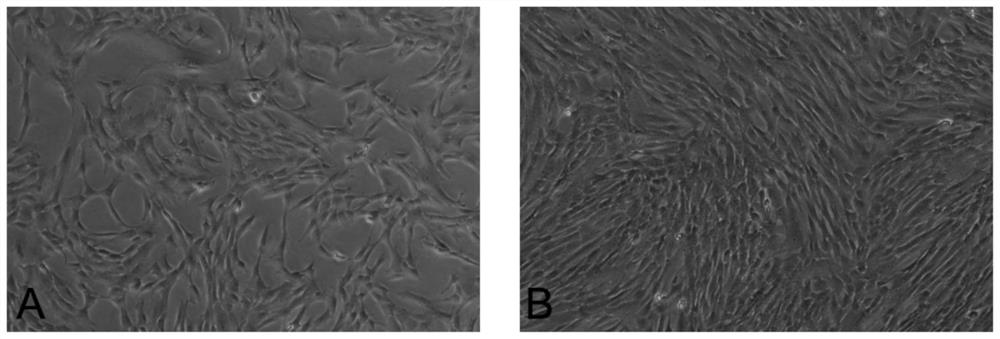Stem cell exosome composition for treating knee osteoarthritis
A technology of exosomes and stem cells, which is applied in the field of cell engineering, can solve the problems of easy loss of single cells and affect the function of cells, and achieve the effects of stable exosomes, easy quality control, and avoiding pollution
- Summary
- Abstract
- Description
- Claims
- Application Information
AI Technical Summary
Problems solved by technology
Method used
Image
Examples
Embodiment 2
[0033]Example 2 Culture of Umbilical Cord Mesenchymal Stem Cells in a Hypoxic Environment
[0034] Harvest the umbilical cord mesenchymal stem cells cultured to P2 in Example 1.
[0035] When the cell confluency reaches 80%, subculture, discard the medium, add PBS to wash twice, add 2 mL of trypsin to digest the cells for 1 min, observe the cells shrinking and rounding under the microscope, add fresh medium to stop digestion, and count on a hemocytometer according to Passage at a density of 80 million / cm2, and inoculate T150 bottles.
[0036] The cells were divided into two groups, which were respectively placed in a normoxic incubator and a three-gas incubator (5% oxygen concentration) to continue culturing. The difference in cell morphology between the two groups was observed under a microscope, and it was found that the cells in the hypoxic environment were smaller than those in the normal oxygen environment (such as image 3 In A), the cell proliferation is faster (such ...
Embodiment 3
[0038] Example 3 Extraction and Identification of Stem Cell Exosomes
[0039] The P3 generation cells passaged in Example 2 were selected for passage, and the P4 generation cells were collected for extraction and identification of exosomes.
[0040] 1. Fetal bovine serum (FBS) to remove exosomes: Use an ultra-high-speed centrifuge, 100,000g, 4°C, centrifuge for 8-12h, remove the exosomes contained in FBS, take the supernatant after centrifugation and store it at 4°C for later use. Labeled No-exo-FBS.
[0041] 2. Prepare medium: pipette No-exo-FBS into a 50ml centrifuge tube, add α-MEM to prepare a complete medium containing 10% No-exo-FBS.
[0042] 3. Digest and harvest the P3 cells cultured in the hypoxic state, use the No-exo-FBS complete medium to inoculate the cells, record it as P4, and place it in a three-gas incubator (oxygen concentration is 5%) to continue culturing.
[0043] 4. After culturing for 48 hours, collect the cell supernatant.
[0044] 5. Centrifuge at 3...
Embodiment 4
[0051] The preparation of embodiment 4 autologous PRP
[0052] 1. Blood drawing: Healthy volunteers with no infectious diseases or blood system diseases, venous blood platelet count greater than 100 000 / μl, no aspirin or other drugs that affect platelet function 3 months before blood sampling, and normal blood routine examination. Sign the informed consent form and agree to blood collection for this experiment. Under sterile conditions, 30 mL of peripheral venous blood was collected from donors using negative pressure blood collection tubes containing sodium citrate anticoagulant.
[0053] 2. Two-step method: transfer 30mL whole blood to a 50mL centrifuge tube with a disposable sterile pipette, first centrifuge at a low speed of 100×g, 20°C for 10min, collect all the plasma layer and buffy coat layer and transfer to another new tube. Then, centrifuge at 400×g at high speed for 10 minutes at 20°C to further concentrate PRP and separate the platelet-poor plasma fraction. Discar...
PUM
| Property | Measurement | Unit |
|---|---|---|
| diameter | aaaaa | aaaaa |
| diameter | aaaaa | aaaaa |
Abstract
Description
Claims
Application Information
 Login to View More
Login to View More - R&D
- Intellectual Property
- Life Sciences
- Materials
- Tech Scout
- Unparalleled Data Quality
- Higher Quality Content
- 60% Fewer Hallucinations
Browse by: Latest US Patents, China's latest patents, Technical Efficacy Thesaurus, Application Domain, Technology Topic, Popular Technical Reports.
© 2025 PatSnap. All rights reserved.Legal|Privacy policy|Modern Slavery Act Transparency Statement|Sitemap|About US| Contact US: help@patsnap.com



